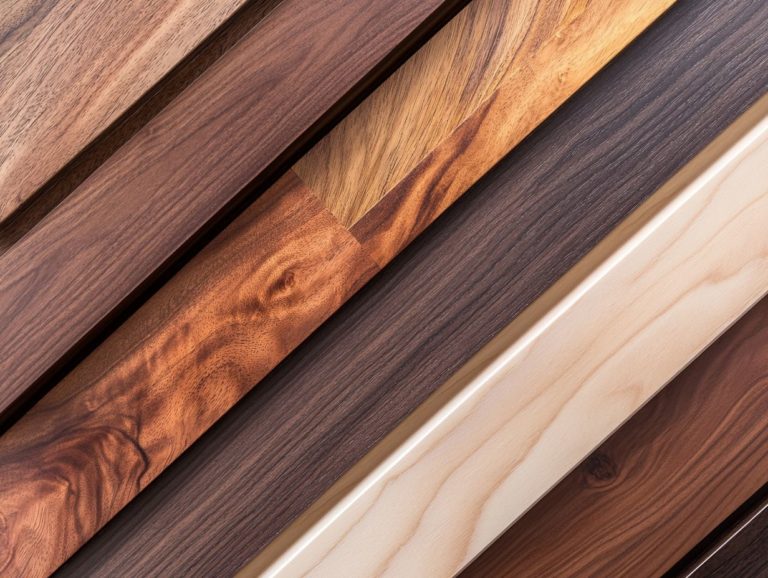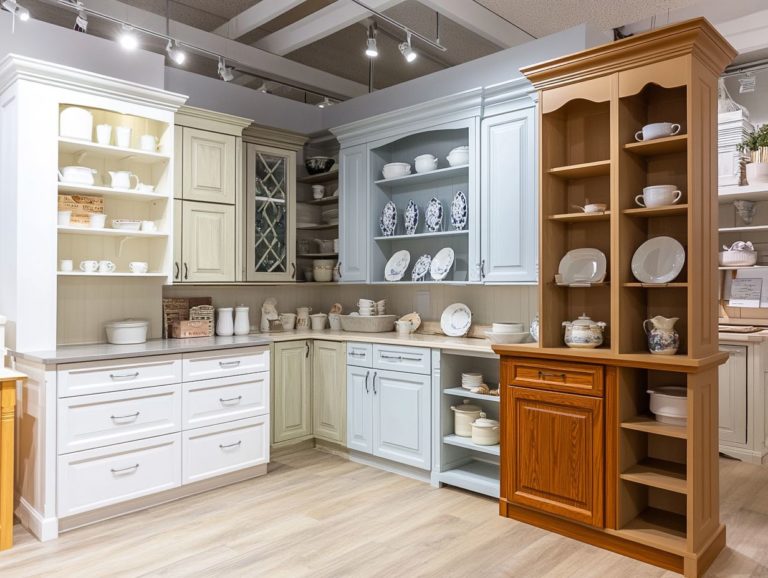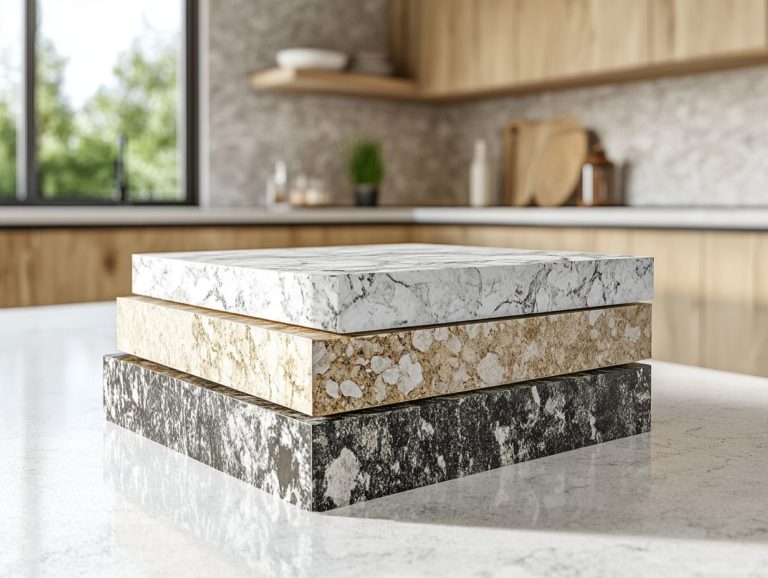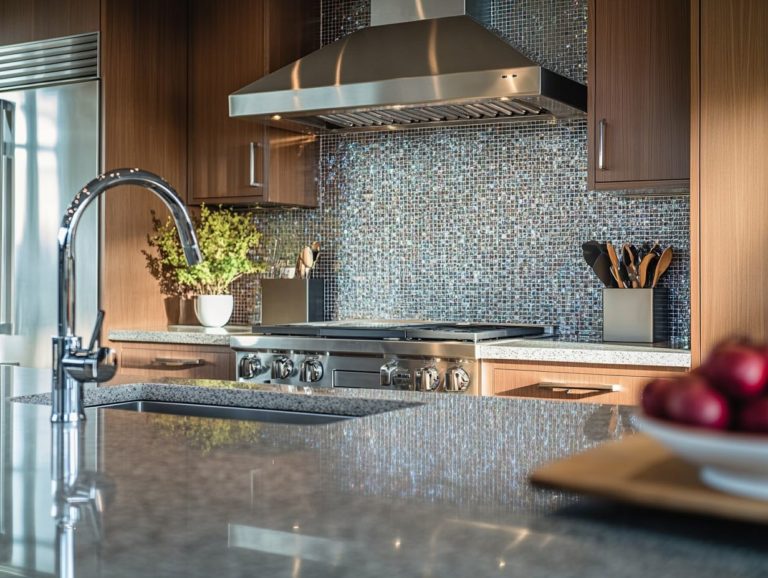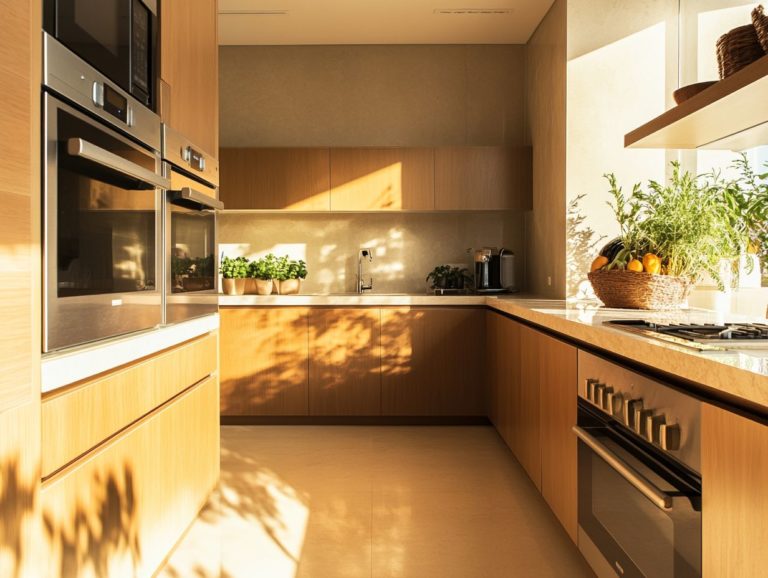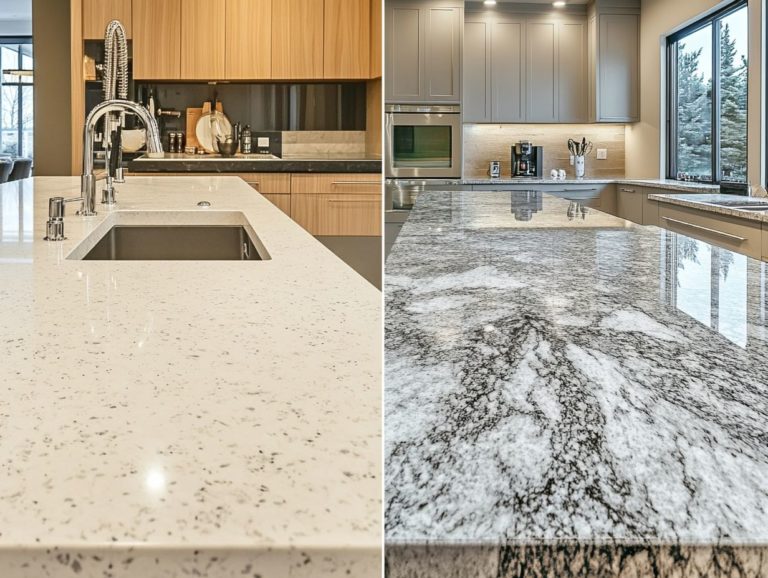How to Select the Best Kitchen Sink Material
Choosing the right kitchen sink material is not just about design; it’s a mix of style, durability, and practicality that defines your culinary space.
With a wide array of options—from the sleek elegance of stainless steel to the timeless charm of rustic cast iron—each material has its unique advantages and drawbacks.
This guide will help you navigate essential factors to consider, like maintenance requirements, aesthetic appeal, and budget constraints.
Delve into the various sink materials and remember to consider what’s necessary for a seamless installation. Discover the perfect sink that complements your kitchen and aligns with your lifestyle!
Contents
- Key Takeaways:
- Factors to Consider when Choosing a Kitchen Sink Material
- Types of Kitchen Sink Materials
- Comparing Different Kitchen Sink Materials
- Factors to Consider for Installation
- Frequently Asked Questions
- Can you give me an overview of the different types of kitchen sink materials?
- What factors should I consider when selecting a kitchen sink material?
- Is stainless steel a good choice for a kitchen sink material?
- What is the most durable kitchen sink material?
- Can I install any type of kitchen sink material with my existing plumbing and countertops?
- Which kitchen sink material is the most cost-effective?
Key Takeaways:
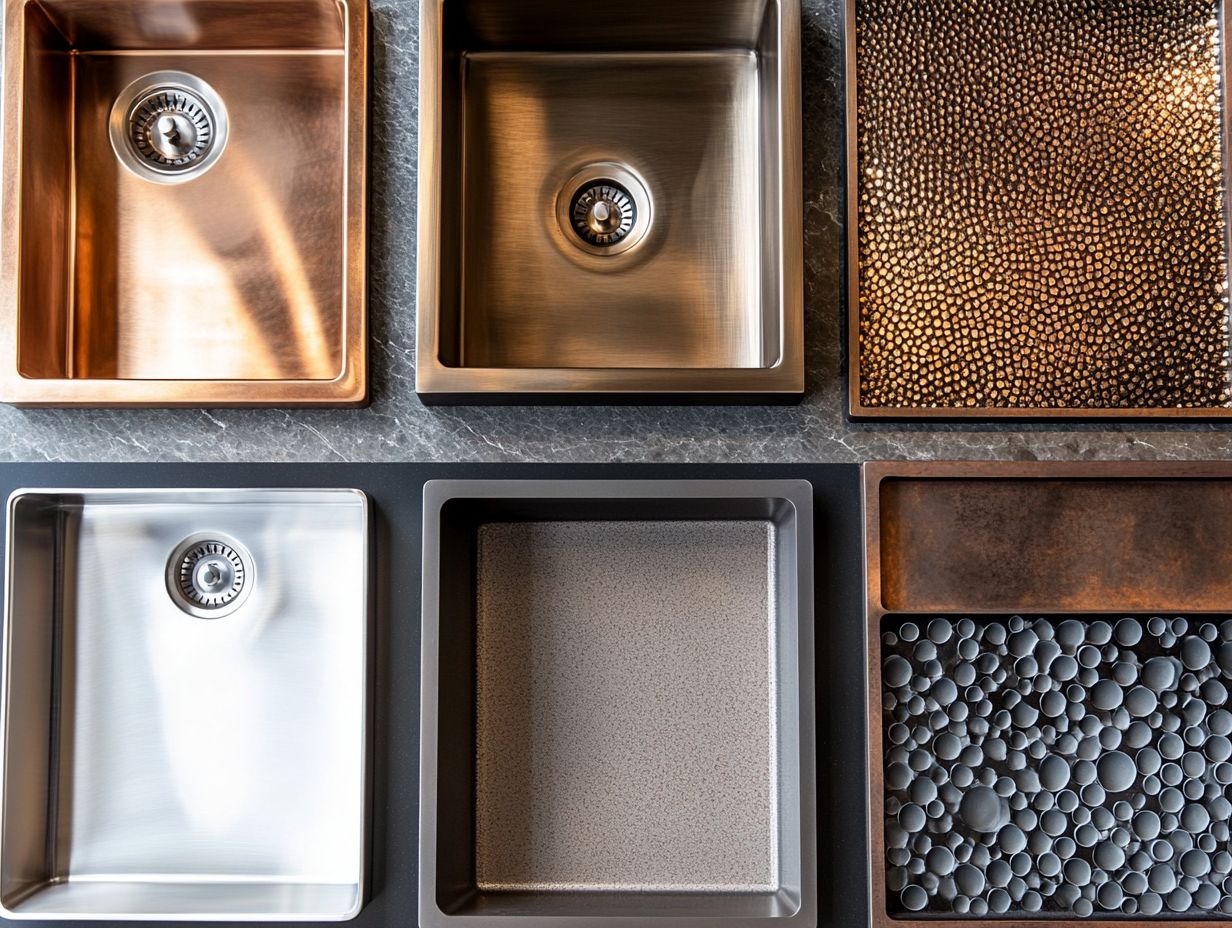
- Choose a kitchen sink material based on durability, maintenance, style, and budget. Consider how often you use your sink and your cleaning habits.
- Popular kitchen sink materials include stainless steel, cast iron, composite granite, fireclay, copper, acrylic, and porcelain. Research the pros and cons of each to find the best fit for your needs.
- When comparing different kitchen sink materials, think about durability, maintenance, cost, and aesthetic appeal. Remember, each material has its unique advantages and disadvantages.
Factors to Consider when Choosing a Kitchen Sink Material
Choosing the perfect kitchen sink material requires thoughtful consideration of key factors like durability, maintenance needs, style, and budget.
Each element plays a vital role in shaping both the functionality and aesthetic appeal of your kitchen.
By carefully evaluating these aspects, you ensure that your sink supports your food preparation habits while adding an elegant touch to your kitchen design.
Durability and Maintenance
When selecting kitchen sink material, durability and maintenance are crucial as they influence the lifespan and upkeep of your sink.
This impacts your daily tasks, from washing dishes to draining pasta and soaking stubborn food residue.
Stainless steel, for example, is celebrated for its resilience and rust resistance, making it a stellar choice for bustling households.
Keep in mind that it may need polishing now and then to maintain its shine.
Copper sinks are undeniably beautiful but require regular treatment to prevent tarnishing.
Enameled cast iron delivers a timeless aesthetic but can chip without care.
Quartz composite strikes a balance between durability and aesthetics, offering a range of colors and typically needing only a quick wipe-down due to its non-porous nature.
Many modern materials also have antimicrobial properties, simplifying cleaning and preventing bacteria buildup, enhancing longevity in your kitchen.
Style and Aesthetics
When considering kitchen sink materials, style and aesthetics are essential. The choice between traditional cast iron and sleek stainless steel can significantly impact your kitchen’s overall design.
Different materials offer unique benefits. For instance, brass exudes an elegant charm that complements classic designs.
Fireclay provides a smooth, glossy finish that enhances everything from traditional farmhouse styles to modern minimalist looks.
If you’re drawn to a contemporary aesthetic, granite composite sinks make a bold statement with diverse colors and textures, offering durability and easy maintenance.
By selecting the right material, you create a cohesive aesthetic that beautifully ties together your cabinetry, countertops, and appliances, elevating your kitchen’s ambiance.
Imagine cooking in a kitchen that reflects your personality! Start exploring your options today to find the perfect kitchen sink that matches your style!
Budget and Cost
Budget and cost considerations are crucial when selecting a kitchen sink material. Prices can vary significantly between options like stainless steel and pricier choices such as copper or fireclay. All of these factors can influence your kitchen upgrades.
This often leads you to weigh the trade-offs between affordability and durability. While low-cost materials like plastic or enamel-coated sinks can serve as temporary solutions, they may require more frequent replacements and repairs. This ultimately leads to higher expenditures over time.
On the other hand, investing in quality materials not only adds aesthetic appeal but also enhances longevity. If you wish to maintain your kitchen’s functionality and style for years to come, choosing premium options like cast iron or natural stone could prove beneficial in the long run. This contributes to a more pleasing and sustainable living environment.
Types of Kitchen Sink Materials
You have many kitchen sink materials at your disposal, each with its own distinct advantages.
For example, stainless steel is renowned for its low maintenance and exceptional durability.
Then there’s enameled cast iron, which not only has an elegant finish but also a classic look that complements any kitchen style.
Stainless Steel
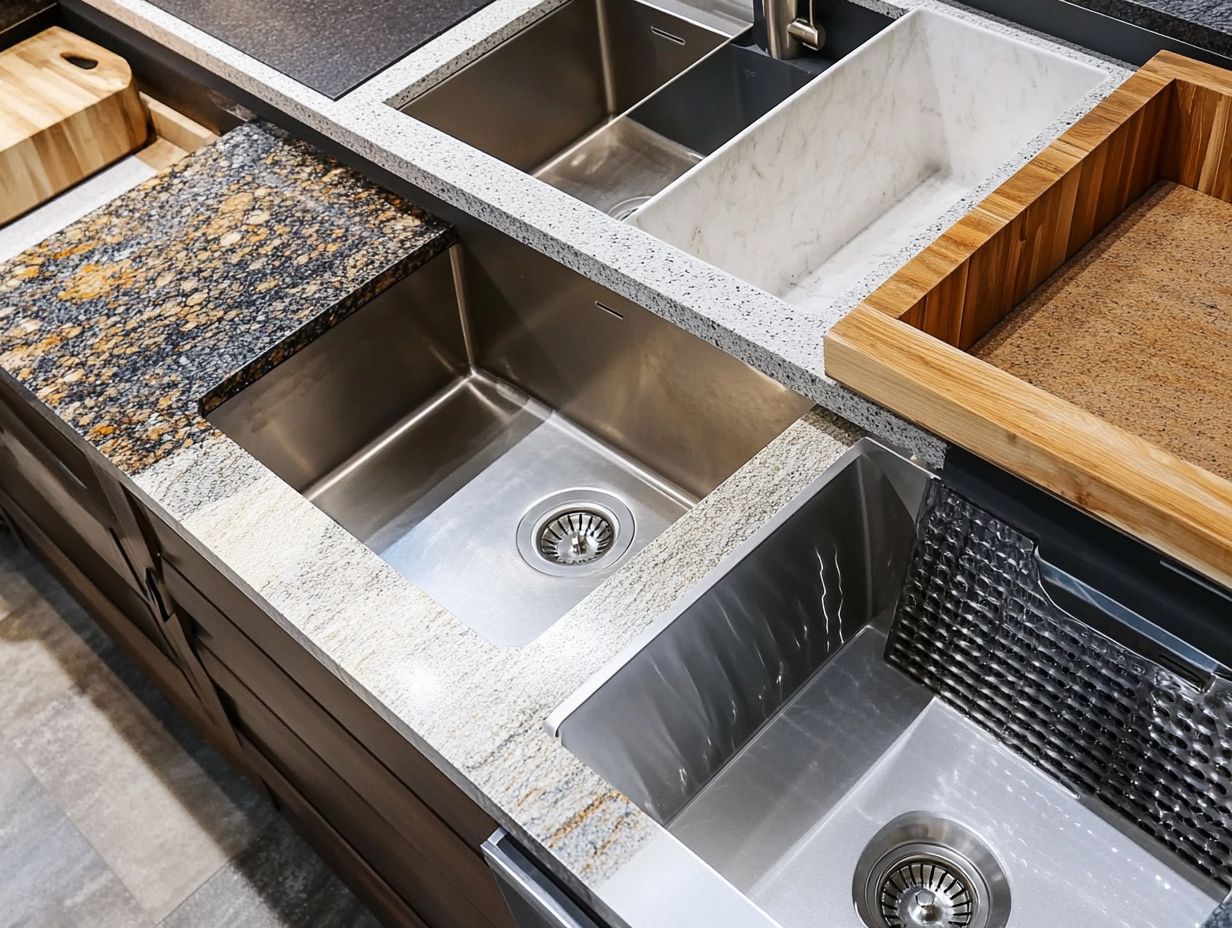
Stainless steel sinks are a top choice for kitchens. They boast high durability, low maintenance needs, and excellent sound dampening properties. They’re perfect for bustling kitchens where food preparation is a daily task.
These sinks offer a sleek, contemporary look and elevate the modern kitchen aesthetic. They seamlessly blend functionality with style. Their smooth surfaces make for effortless cleaning, preventing food particles and grime from clinging—a significant advantage for busy households.
Stainless steel resists stains and odors naturally, ensuring that your sink maintains its pristine appearance over time.
Keep your stainless steel sink shiny with a regular wipe-down using mild detergent and a non-abrasive cloth. Don’t forget an annual polishing with specialized stainless steel cleaners to fend off any dullness. This allows your sink to truly shine in every culinary endeavor.
Cast Iron
Enameled cast iron sinks are a marvel, celebrated for their traditional style and elegant finish. They are durable and have a classic look that enhances the overall aesthetics of your kitchen.
Not only do these sinks have a classic look, but they also boast excellent heat retention properties. This makes them perfect for cooking enthusiasts like you. The smooth, non-porous surface ensures effortless cleaning, which is essential for maintaining hygiene in your culinary space.
While they are resistant to chipping and scratching, it’s wise to handle them with care to prevent any potential damage.
A simple routine of gentle cleaning with mild soap and occasional polishing can keep your sink looking pristine. When integrated into traditional kitchen designs, their rich colors and glistening finish beautifully complement vintage cabinetry and farmhouse decor, adding both character and functionality to your home.
Composite Granite
Composite granite sinks combine the durability of natural stone with exceptional stain resistance. They are a brilliant choice for anyone seeking both functionality and elegance in their kitchen.
Made to last, these sinks are tough and ready for anything your kitchen throws at them! They resist scratches and chips far better than traditional materials like porcelain or stainless steel.
You’ll love how easy they are to take care of; a simple wipe down with mild cleaners is all it takes to keep them looking brand new.
This perfect blend of resilience and low upkeep positions composite granite sinks as an ideal centerpiece in modern kitchen designs.
With a variety of colors and styles available, they enhance your overall decor while seamlessly integrating with contemporary appliances.
Fireclay
Fireclay sinks are celebrated for their timeless elegance. They offer a stain-resistant solution that blends practicality with beauty, making them suitable for any kitchen design.
These sinks infuse classic charm into your space. They also demonstrate outstanding resilience against scratches and chips, making them a smart investment for bustling households.
Their glossy surface enhances both modern and rustic aesthetics. This allows them to integrate seamlessly into various decors.
Maintenance is refreshingly simple; a gentle cleanser and sponge are all you need to keep them looking immaculate. By steering clear of harsh chemicals, you can extend their stunning finish.
With such versatility, these sinks can serve as a captivating centerpiece in open-concept areas or blend effortlessly into cozy, traditional kitchens.
Copper
Copper sinks offer a beautiful finish and natural antimicrobial properties. They are not just visually captivating but also a practical choice for kitchens that prioritize cleanliness.
These exceptional fixtures resist bacteria and viruses, adding an extra layer of safety to your food preparation areas.
Over time, the surface of a copper sink develops a stunning patina, which tells a story and enhances the overall charm of your kitchen space. This evolving hue blends effortlessly with various design styles, from rustic to modern.
A simple routine of regular cleaning with mild soap is all it takes to preserve its allure, maintaining its unique characteristics.
Acrylic
Acrylic sinks present a lightweight and budget-friendly option that adds a touch of modern sophistication. They are an enticing choice for your kitchen without compromising on style.
These sinks are available in a stunning array of colors and shapes, allowing you to integrate them into any aesthetic. Whether your space leans towards the contemporary or embraces traditional elements, an acrylic sink can enhance the overall visual appeal.
While acrylic sinks are affordable and flexible, maintenance is key. They can scratch more easily than other materials, potentially impacting their durability over time.
Regular upkeep is necessary to keep them looking their best, so it’s wise to weigh this factor before committing to this stylish choice.
Porcelain
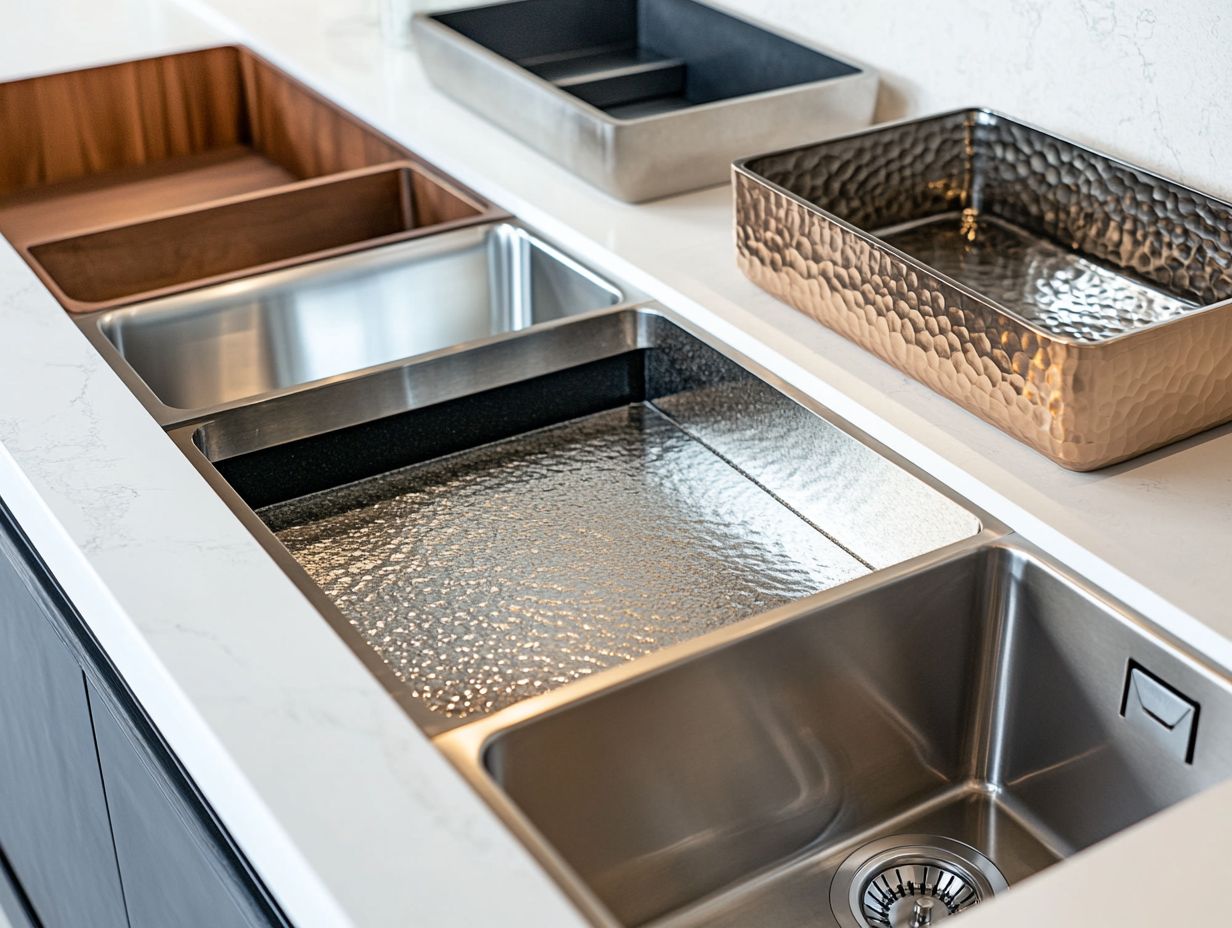
Porcelain sinks, typically crafted from vitreous china (a type of glass-like ceramic), present a beautiful finish that never goes out of style. They are ideal for those who wish to elevate their kitchen’s charm.
These sinks are not just visually stunning; they are incredibly versatile, seamlessly integrating into a range of design styles from classic to contemporary. Their glossy surface can illuminate any space, making them a favored choice among interior designers.
Unlike materials such as stainless steel or composite, porcelain offers a durable yet delicate option for daily use. However, a bit of care is necessary, as they can chip if treated roughly.
Cleaning these sinks is a breeze; gentle, non-abrasive cleaners will keep them looking as good as new, unlike other materials that often demand harsher treatments.
Comparing Different Kitchen Sink Materials
When comparing kitchen sink materials, evaluate each option’s pros and cons. It’s crucial to carefully assess the advantages and disadvantages of each option.
Consider factors such as durability, maintenance needs, and aesthetic appeal to find the perfect match for your home.
Pros and Cons of Each Material
Each kitchen sink material has its unique set of advantages and disadvantages that can significantly influence its functionality and visual appeal in your space. From the robust durability of stainless steel to the refined elegance of fireclay, understanding these distinctions is essential for making a choice that suits your lifestyle.
Take stainless steel, for example. While it offers impressive strength and resistance to corrosion, its tendency to show scratches and water spots may not be appealing to everyone. On the other hand, fireclay sinks present a timeless, smooth surface that can enhance the aesthetic of any kitchen, but they require careful handling to prevent chipping.
When choosing your sink material, consider factors like maintenance needs, aesthetic compatibility, and your cooking habits. These elements will guide you toward a decision that aligns with your culinary lifestyle and design preferences.
Factors to Consider for Installation
When planning for sink installation, there are several crucial factors to consider.
Ensure compatibility with your countertops and cabinets, assess the complexity of the installation process, and evaluate how these choices align with your overall kitchen design and maintenance requirements.
Addressing these elements will lead to a seamless and harmonious kitchen space.
Compatibility with Countertops and Cabinets
Ensuring compatibility between your kitchen sink and countertops or cabinets is vital for achieving a cohesive kitchen design. Mismatched materials or sizes can lead to problems with fit and visual inconsistencies that you’ll want to avoid.
Finding the right balance not only enhances the functionality of your kitchen but also creates a visually pleasing environment. For instance, a sleek stainless steel sink can beautifully complement modern quartz countertops, while a farmhouse sink made from fireclay pairs perfectly with rustic wooden cabinets.
During the planning phase, consider factors such as color, texture, and material durability. Combining ceramic sinks with granite countertops can offer both style and longevity. Remember to account for the weight and support needed for heavier materials to avoid any installation challenges later on.
Installation Process and Difficulty
The installation process for a kitchen sink can vary in difficulty based on your chosen material, the complexity of your existing plumbing, and your kitchen’s overall design. Each of these factors can significantly affect the time and effort needed for a successful installation.
If you opt for a stainless steel sink, you’re in luck. These typically allow for easier DIY installations due to their lightweight nature and straightforward drop-in or undermount designs, which means they sit below the countertop for a clean look.
If you prefer materials like cast iron or solid surface, be prepared for a more challenging task. Their weight and specific mounting requirements may demand extra attention and support. If your plumbing setup is complex, this could add another layer of difficulty, possibly requiring adjustments or extra components.
If the task feels overwhelming or involves intricate plumbing changes, don’t hesitate to call in a professional. This can help ensure the job is done correctly and efficiently, ultimately saving you time and avoiding potential complications later.
Frequently Asked Questions
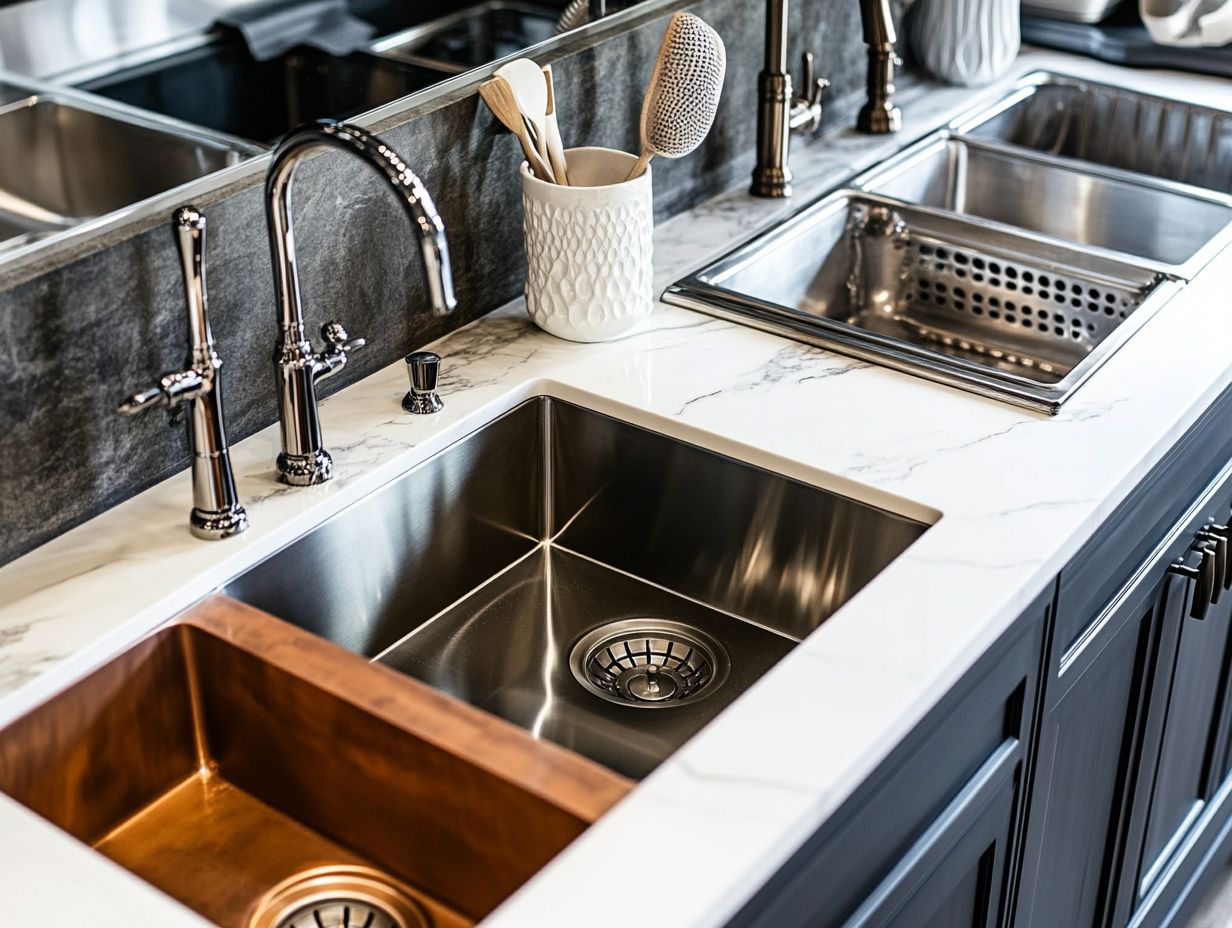
Can you give me an overview of the different types of kitchen sink materials?
Common types of kitchen sink materials include stainless steel, cast iron, composite granite, fireclay, copper, and porcelain. Each material comes with unique properties and advantages.
What factors should I consider when selecting a kitchen sink material?
The most important factors are durability, maintenance, style and design, cost, and compatibility with your kitchen’s plumbing and countertops.
Is stainless steel a good choice for a kitchen sink material?
Yes, stainless steel is a popular choice for kitchen sinks because it is durable, easy to clean, and can match various kitchen styles. However, it can be prone to scratches and may produce noise when water hits the surface.
Explore various sink options or consult a professional for installation to ensure you find the perfect fit for your kitchen!
What is the most durable kitchen sink material?
Cast iron and fireclay are known for their durability. They resist scratches, dents, and stains, but they can be heavy and may need extra support.
Can I install any type of kitchen sink material with my existing plumbing and countertops?
You cannot install just any sink material. Some, like cast iron and fireclay, require additional support due to their weight.
Also, certain plumbing types may not work well with all sink materials. Talk to an expert to find the right sink for your kitchen!
Which kitchen sink material is the most cost-effective?
Stainless steel and composite granite are typically more affordable. Remember, the overall cost also depends on the sink’s size and style.
